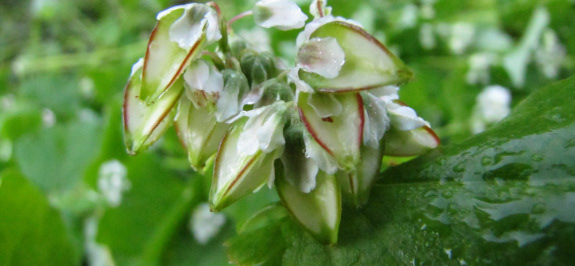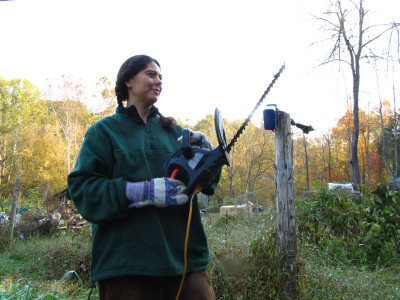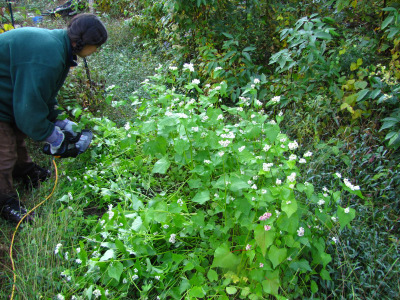
Cutting buckwheat with a hedge trimmer

 Cover
crops take almost no effort, but you do need to keep an eye on them and
make sure they don't go to seed. I thought that buckwheat planted
on August 24 would be killed by the first frost just as it reached peak
maturity, but we dodged the early frost bullet last week, and now our
buckwheat is starting to develop young fruits.
Cover
crops take almost no effort, but you do need to keep an eye on them and
make sure they don't go to seed. I thought that buckwheat planted
on August 24 would be killed by the first frost just as it reached peak
maturity, but we dodged the early frost bullet last week, and now our
buckwheat is starting to develop young fruits.
I mowed down
our first round of buckwheat, but I wasn't very happy
with the results ---  buckwheat
bits flew everywhere, and some plants got mashed down and then
regrew. This time, I decided to try out the electric hedge
trimmer Mark got at a yard sale for $10.
buckwheat
bits flew everywhere, and some plants got mashed down and then
regrew. This time, I decided to try out the electric hedge
trimmer Mark got at a yard sale for $10.
As you can see, the
sickle-type mowing blade made short work of our succulent buckwheat
stems. I slid the hedge trimmer through the buckwheat about an
inch above the ground and was done cutting in about a minute. A
minute after that, I'd finished tossing the few stems that slid off the
bed back on top of the growing area.

The buckwheat worked as
advertised in our loamy upper garden --- maturity in precisely six
weeks. Of course, the real test will be the quantity of dried
organic matter we get, compared to the amount of organic matter that
results from our slightly shorter but tougher oat stems.
No matter which cover
crops win my long term attention, I can tell that the electric hedge
trimmer has a future in our grain experiments.
Want more in-depth information? Browse through our books.
Or explore more posts by date or by subject.
About us: Anna Hess and Mark Hamilton spent over a decade living self-sufficiently in the mountains of Virginia before moving north to start over from scratch in the foothills of Ohio. They've experimented with permaculture, no-till gardening, trailersteading, home-based microbusinesses and much more, writing about their adventures in both blogs and books.
Want to be notified when new comments are posted on this page? Click on the RSS button after you add a comment to subscribe to the comment feed, or simply check the box beside "email replies to me" while writing your comment.

We discovered this summer that the electric hedge trimmer wasn't up to cutting really serious weeds in our yard, but hopefully it'll be tough enough to cut wheat and oats. It definitely had no problem with buckwheat.
Thanks for your feedback on kangaroos on your site --- it sounds a lot like deer over here. I also really enjoyed reading one of your old posts about growing mushrooms out of mushroom compost --- very cool!